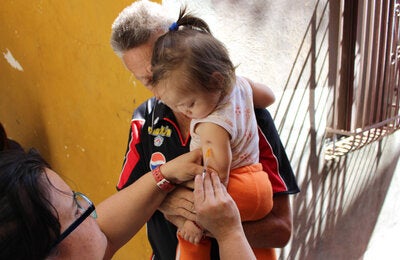Saying the time is now to capitalize on a decade of advances against tuberculosis in the Americas, health officials from across the region today pledged to accelerate still further their efforts against the disease.
Since 2010, the fight against TB has slowed in the region, while rapid urbanization has created new pockets of poverty that foster the disease.
Washington, D.C., 30 September 2015 (PAHO/WHO) — Saying the time is now to capitalize on a decade of advances against tuberculosis in the Americas, health officials from across the region today pledged to accelerate still further their efforts against the disease.
The Plan of Action for the Prevention and Control of Tuberculosis, approved at the 54th Directing Council of the Pan American Health Organization (PAHO), commits the region's to reducing TB deaths rates by at least 24% by 2019. To achieve this goal, the plan calls for ramping up patient-centered care, advancing research on TB prevention and control, mobilizing new funding for anti-TB efforts and ensuring engagement in these efforts at the community level and across different sectors.
The plan mirrors and supports targets set by the World Health Organization (WHO) last year in its new, post-2105 "End TB Strategy," which seeks major reductions in TB by 2035 to pave the way for eliminating the disease as a global health problem by 2050.
"Ending the tuberculosis epidemic will require bold policies and supportive health systems in the context of universal health coverage, to ensure that no one lacks access to early diagnosis or the treatment they need," said Dr. Marcos Espinal, Director of Communicable Diseases and Health Analysis at PAHO/WHO. "This plan provides the countries of the Americas with the guidance they need to achieve that goal."
The countries of the Americas have made real advances in reducing the burden of TB over the past two decades, but it continues to be one of the region's leading infectious causes of death, along with HIV/AIDS. Special challenges include the rapid growth of cities and slums, the increase in noncommunicable diseases and especially diabetes, increases in multidrug-resistant TB (MDR-TB), and co-infections of TB and HIV.
Tuberculosis is a bacterial infection most commonly found in the lungs that can spread through the lymph nodes and bloodstream to any organ in the body. Transmitted from person to person through the air, usually through coughs or sneezes it is both curable and preventable.
Since 2000 more than 37 million lives around the world have been saved through effective diagnosis and treatment. In the Americas, TB incidence dropped by 48.2% and deaths declined 68% between 1990 and 2013, thanks largely to the implementation by member countries of public health measures promoted by PAHO/WHO.
But that progress is slowing. Complicating efforts to control the disease in the Americas are the rapid growth of marginal neighborhoods with overcrowded living conditions, poor water and sanitation services and limited access to health care. In 2013, countries in the Americas reported 220,510 cases of TB, mostly among vulnerable urban populations. Of the total reported cases, 95% were people over age 15, 63% were men and 31% were unaware of their HIV status. However, data for 2013 also suggest that over 65,000 TB infections and half of MDG-TB cases were not diagnosed or reported. One in four cases was not successfully treated. The vast majority of cases were concentrated in four countries: Brazil, Peru, Mexico and Haiti.
Approval of the new plan came during the annual meeting of ministers of health at PAHO headquarters this week.
Links
— 54th Directing Council
— Documents of 54th Directing Council
— PAHO Governing Bodies
— https://twitter.com/pahowho #PAHODC54



